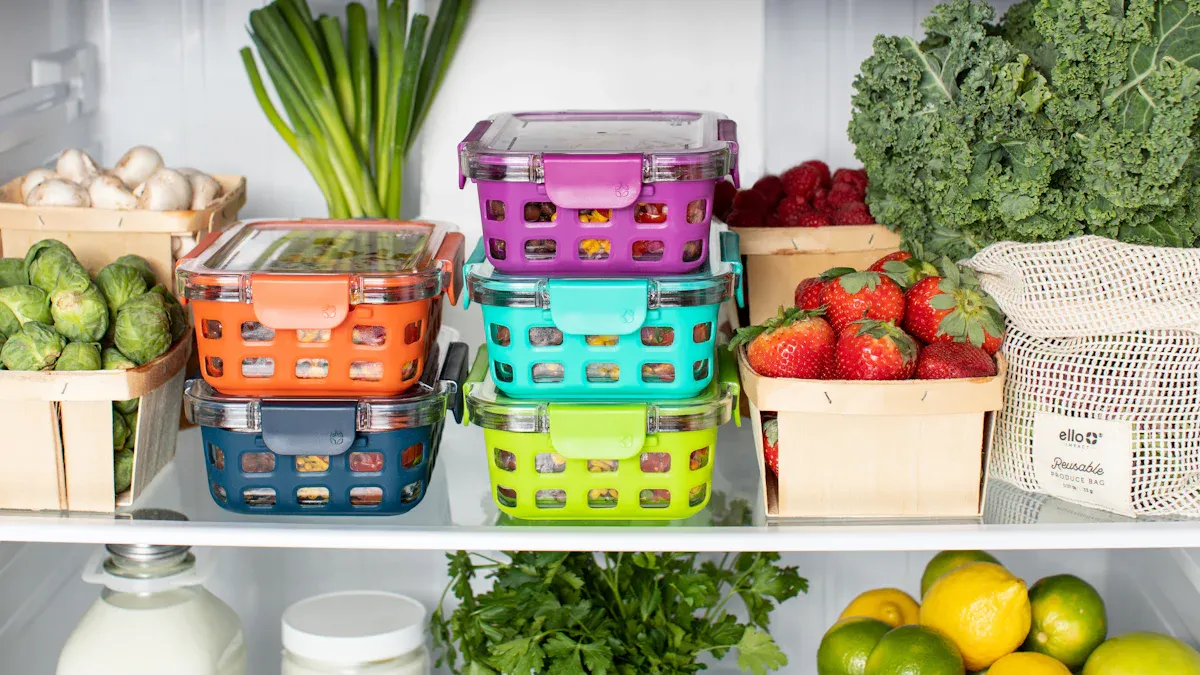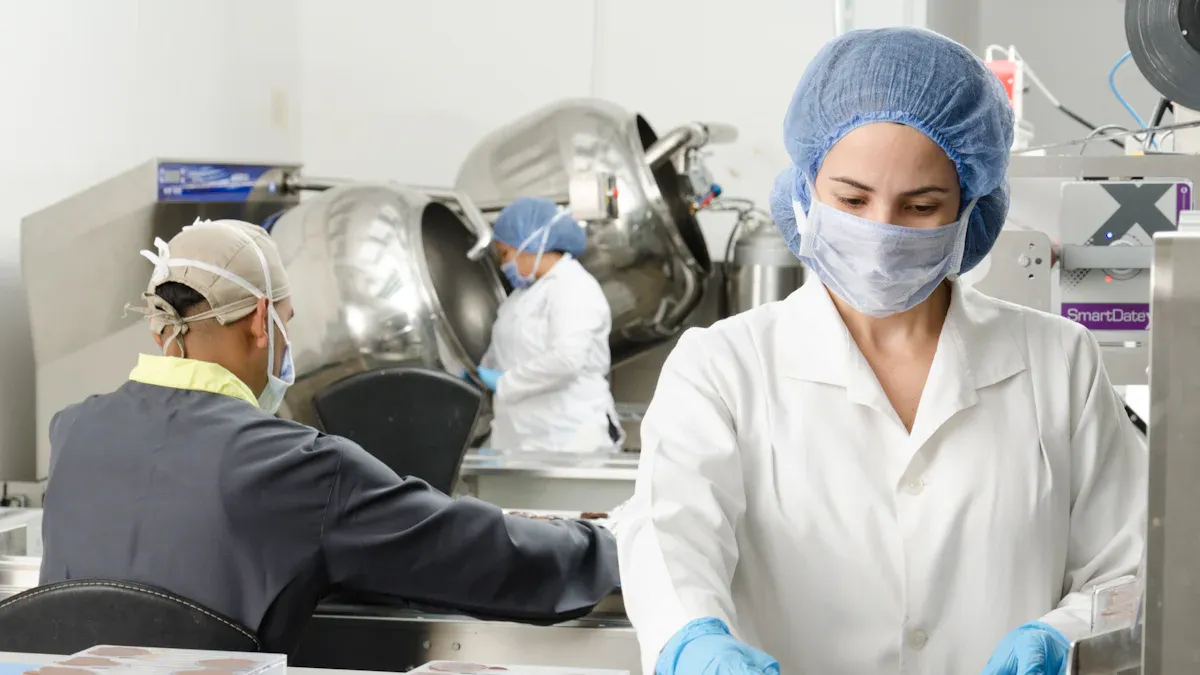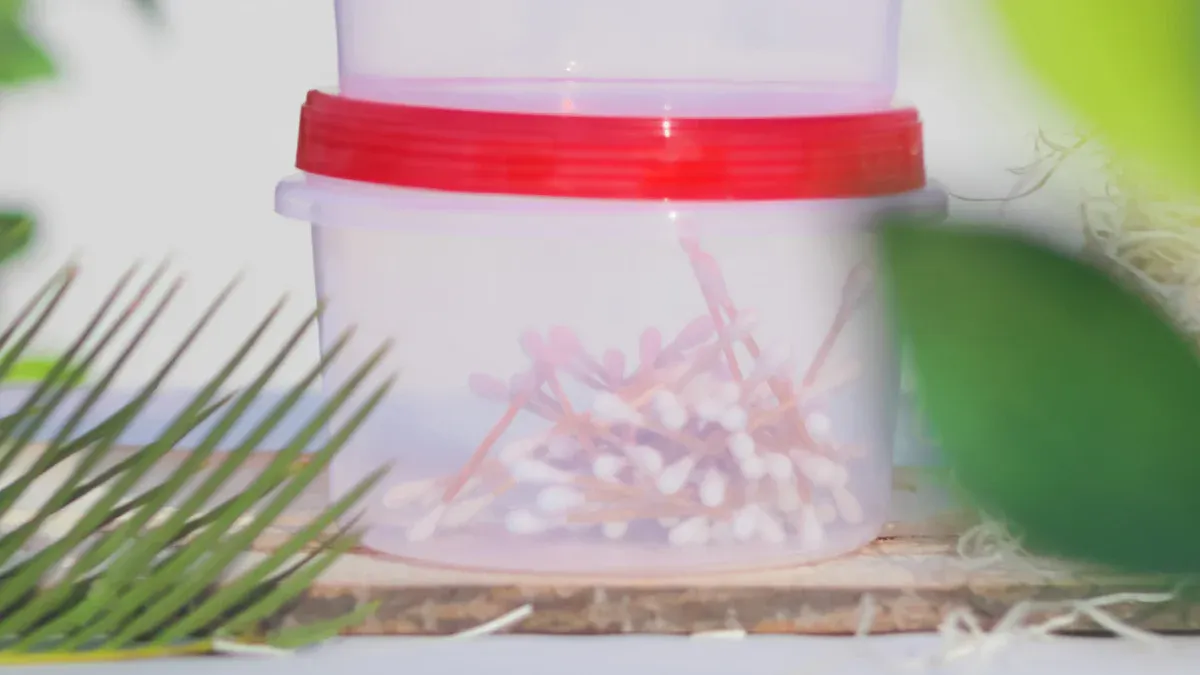
Ensuring food safety starts with strict adherence to FDA standards. These regulatory guidelines protect public health by governing the materials and processes used for food-contact plastics. For example, food-grade resins like polyethylene and polypropylene offer non-toxic, chemically resistant options for sanitary components. Plastic injection molding plays a critical role here, delivering durable, contamination-free parts in high volumes. Without such certifications, harmful additives or poor manufacturing practices could compromise health. By following FDA standards and good manufacturing practices, you can build trust with consumers while meeting safety expectations.
FDA plastic for food contact refers to materials specifically designed and approved for safe interaction with food. These plastics meet stringent FDA regulations to prevent harmful substances from migrating into food products. They are chemically stable, non-toxic, and resistant to contamination, ensuring food safety during manufacturing, packaging, and storage.
Food-grade plastics must adhere to compliance standards outlined in FDA guidelines under Title 21 CFR. These standards specify permissible materials, additives, and processes for food-contact applications. For example, polyethylene and polypropylene are commonly used due to their durability and safety. Additionally, NSF standards complement FDA regulations by providing sanitation guidelines for food-contact materials.
Food-safe plastics undergo rigorous evaluations, including premarket approval processes, to ensure they meet safety requirements. They are designed to withstand cleaning and sanitization without compromising their integrity. This makes them ideal for applications like food packaging, utensils, and processing equipment.
FDA compliance plays a vital role in protecting food safety. It ensures that the materials used in food-contact applications do not introduce contaminants or pose health risks. Without compliance, food products could be exposed to harmful chemicals, jeopardizing public health and consumer trust.
The FDA emphasizes a proactive approach to food safety through initiatives like inspections, sampling, and recalls. These measures help identify and address potential risks before they escalate. For instance, regular checks on food production facilities ensure adherence to compliance standards, while scientific methods validate the safety of food-contact materials.
Strong partnerships and rigorous testing are essential for maintaining food safety. The FDA collaborates with manufacturers to reduce the burden of foodborne illnesses. By following FDA regulations, you can contribute to a safer food supply chain and build confidence among consumers.
Non-compliance in food-contact applications can lead to serious risks. Studies show that many food contact chemicals (FCCs) detected in materials are not listed for approved use. Over 12,000 FCCs could be intentionally used in manufacturing food-contact plastics, with additional non-intentionally added substances (NIAS) potentially present. These substances may pose health risks, including carcinogenicity, mutagenicity, and endocrine disruption.
Incomplete toxicity data further complicates safety assessments, making it difficult to evaluate the full impact of non-compliance. For example, plastic components in food packaging or processing equipment could leach harmful chemicals into food products. This not only endangers public health but also damages industry reputation.
To mitigate these risks, you must prioritize FDA compliance and invest in safe manufacturing practices. Using FDA-approved materials and conducting thorough safety testing can help prevent contamination. Additionally, maintaining proper documentation ensures transparency and accountability during audits.

The FDA standards under CFR Title 21 establish the foundation for ensuring the safety of food-contact materials. These regulations outline the requirements for chemical composition, conditions of use, and migration testing. For example, manufacturers must provide detailed information about the chemical name and CAS registry number of each food contact substance. They must also demonstrate that the material remains safe under specific conditions, such as temperature, food type, and contact duration.
The FDA categorizes food additives into direct, secondary direct, and indirect additives. Each category has unique safety requirements. For instance, migration data must validate that no harmful substances transfer to food under worst-case conditions. Additionally, toxicological information ensures that the material and its impurities pose no health risks. These standards help you maintain compliance and protect public health.
| Requirement | Description |
|---|---|
| Chemical Composition | The chemical name and CAS registry number of the substance. |
| Conditions of Use | Information on temperature, food type, contact duration, and usage type. |
| Migration Data | Validated data under worst-case conditions, including analytical methods. |
| Toxicological Info | Analysis of existing data on the substance and its impurities. |
Good Manufacturing Practices (GMP) play a critical role in maintaining FDA compliance. GMP ensures that every step of the manufacturing process meets strict safety and quality standards. For example, proper documentation helps you track material compliance and prepare for FDA audits. Change control is another essential aspect. Any modification in the supply chain can affect the safety of food-contact materials, so you must oversee all suppliers, including Tier 2 and Tier 3.
ISO 13485 certification has become increasingly important for manufacturers. It demonstrates that you understand and implement risk management principles. By following GMP, you can ensure that hygienic components meet FDA standards and remain safe for food packaging applications.
The FDA has specific requirements for food-contact materials and additives to ensure safety. Substances recognized as Generally Recognized as Safe (GRAS) do not require FDA approval. However, materials not covered by existing regulations must undergo a Food Contact Notification (FCN) process. This involves submitting safety data to demonstrate that the material is safe for its intended use.
The FDA also uses the Threshold of Regulation (TOR) exemption for materials with minimal exposure, such as less than 0.5 parts per billion. These requirements ensure that food packaging applications and other uses of plastic remain safe for consumers. By adhering to these regulations, you can minimize risks and maintain trust in your products.
| Regulation Type | Description |
|---|---|
| GRAS | Substances recognized as safe without FDA approval, listed in 21 CFR Parts 182, 184, and 186. |
| TOR | Exemption for materials resulting in exposure of less than 0.5 ppb. |
| FCN | Notification for materials not covered by existing regulations, requiring safety data submission. |
Choosing the right materials is the first step in ensuring compliance for food-contact applications. You must select materials that meet FDA standards and are safe for food interaction. These materials should be chemically stable, non-toxic, and resistant to contamination. The FDA provides clear guidelines under the Code of Federal Regulations (CFR) for approved raw materials. For example, polyethylene and polypropylene are common choices for food-grade plastics due to their durability and safety.
The Food Contact Notification (FCN) system is another critical resource. It allows you to submit detailed applications about the chemical composition and intended use of food-contact substances. Once approved, the FCN grants permission for you and your customers to use the material. Pre-notification consultations with the FDA can help refine your submissions and improve approval chances.
Here’s a quick overview of the requirements for selecting FDA-approved materials:
| Requirement | Description |
|---|---|
| Approved Raw Materials | Materials must be created from raw materials listed in the Code of Federal Regulations. |
| Food Contact Notification | Materials can be approved through the FCN system, which details safety evidence for intended use. |
| Exemptions | Certain materials may be exempt if they meet criteria like having a physical barrier that prevents migration to food. |
By adhering to these guidelines, you can ensure that your compliant plastic parts meet the highest safety standards for food-contact applications.
Safety testing is essential to verify that your plastic injection molding process produces compliant plastic parts. Testing ensures that no harmful substances migrate from the plastic into food. It also confirms that the materials maintain their integrity under various conditions, such as high temperatures or prolonged contact with food.
You can use specialized tools to assess the skills and knowledge of your team involved in plastic injection molding. For instance, the Plastic411 Processing Assessment and Paulson Training SkillTest evaluate the expertise of operators, technicians, and engineers. These tools help identify gaps in knowledge and improve the overall quality of your manufacturing process.
| Resource Name | Description |
|---|---|
| Plastic411 Processing Assessment | A 100-question quiz to assess plastic injection skill levels, from material handler to process engineer. |
| Paulson Training SkillTest | An assessment tool measuring knowledge and skills of injection molding personnel across three levels: operators, technicians, and engineers. |
In addition to skill assessments, you should conduct migration testing to ensure compliance with FDA standards. This involves analyzing whether any chemicals transfer from the plastic to the food under worst-case conditions. Certification from accredited laboratories further validates the safety of your food-grade plastic products. These steps not only protect public health but also enhance consumer trust in your packaging solutions.
Implementing FDA-compliant manufacturing processes is crucial for producing safe and high-quality plastic products. Good Manufacturing Practices (GMP) form the backbone of compliance. These practices ensure that every step of your production process meets strict safety and quality standards.
Start by maintaining detailed records of your operations. Accurate documentation helps you demonstrate compliance during FDA audits. Regularly review and update your records to reflect the latest regulatory standards and operational procedures. Focus on high-risk areas during audits to address potential compliance threats effectively.
Here are some best practices for ensuring compliance in your manufacturing processes:
By following these practices, you can create a manufacturing environment that consistently produces compliant plastic parts. This not only ensures food safety but also strengthens your reputation as a reliable supplier of food-grade plastics.
Maintaining proper documentation is essential for ensuring compliance with FDA regulations in food safety plastic molding. Accurate and organized records not only demonstrate your commitment to food safety but also prepare you for FDA audits. Inspectors often request specific documents during audits, and having them readily available can save time and reduce stress.
To streamline your documentation process, you should establish clear procedures. Start by creating a standard operating procedure (SOP) that outlines how data is collected, reviewed, and stored. This ensures consistency and helps your team understand their responsibilities. For example, an SOP might specify how to log material compliance data or track changes in manufacturing processes.
Using digital tools can further enhance your documentation efforts. Secure electronic systems allow you to capture, validate, and archive data efficiently. These tools also support version control, enabling you to track changes in real time. This reduces the risk of losing vital information and ensures your records remain accurate.
Regular internal audits play a crucial role in maintaining documentation. By scheduling routine checks, you can identify gaps in your records and address them promptly. This proactive approach keeps you inspection-ready and helps you avoid surprises during FDA audits. For instance, reviewing your training records and quality management system (QMS) documents can highlight areas that need improvement.
Here are some best practices for maintaining documentation for FDA audits:
During an FDA audit, inspectors may request a variety of documents. These could include your quality manual, organizational chart, and device listings. Having these records well-organized and up-to-date creates a favorable impression and demonstrates your commitment to compliance. If inspectors identify any objectionable conditions, addressing them promptly can help maintain a positive relationship with the FDA.
By following these practices, you can ensure that your documentation supports food safety plastic molding operations. Proper records not only protect public health but also strengthen trust in your products. Staying prepared for audits reflects your dedication to producing safe and high-quality food-contact plastics.

FDA-compliant plastic molding has revolutionized food packaging by offering innovative solutions that enhance safety and sustainability. Active packaging technologies now incorporate antioxidants and biopolymers to extend the shelf life of perishable items like fresh produce. These advancements not only improve food safety but also align with consumer demand for eco-friendly options. For instance, bioplastics have gained significant traction in the market, particularly in Europe, which held 34% of the global bioplastics market share in 2023. This trend highlights the growing preference for biodegradable alternatives over conventional plastics.
The integration of essential oils into packaging materials has further enhanced antimicrobial properties, ensuring natural food preservation. Additionally, zero-waste packaging solutions are on the rise, with the market projected to grow from $294.57 billion in 2024 to over $740 billion by 2034. These innovations demonstrate how FDA-compliant plastic materials are shaping the future of food packaging while addressing environmental concerns.
| Trend/Example | Details |
|---|---|
| Bioplastics Market Share | In 2023, Europe held a 34% share of the global bioplastics market, driven by the food sector. |
| Zero-Waste Packaging Market Value | Valued at $294.57 billion in 2024, projected to exceed $740.06 billion by 2034. |
| Consumer Engagement with QR Codes | 57% of consumers scanned QR codes for product information, enhancing transparency. |
Utensils and kitchenware made from FDA-compliant plastics ensure safety and durability in everyday use. These products undergo rigorous testing to meet safety standards. For example, performance testing evaluates their functionality under normal conditions, while impact resistance tests determine their ability to withstand sudden force. Materials like stainless steel have shown reduced metal release with repeated use, making them safer over time. However, certain materials, such as copper alloys, may exceed safety levels for specific metals, emphasizing the importance of careful material selection.
Comprehensive evaluations, including food contact substance analysis and extractable testing, ensure that these products do not leach harmful substances into food. By choosing FDA-compliant kitchenware, you can prioritize safety and quality in your cooking and dining experiences.
FDA-compliant plastic components play a vital role in food processing and handling equipment. These parts ensure hygiene, efficiency, and safety throughout the food supply chain. For example, PTFE conveyor components have been widely adopted for their ability to maintain cleanliness and streamline operations. Similarly, a bakery improved its production efficiency by using locally sourced FDA-approved polymer parts, which reduced delivery times and enhanced safety.
These components are designed to withstand harsh conditions, such as high temperatures and chemical exposure, without compromising food safety. By incorporating FDA-compliant plastics into your equipment, you can meet regulatory standards while optimizing performance.
Sustainability has become a key focus in the development of FDA-compliant plastic for food contact. As environmental concerns grow, you can see a shift toward using recycled and biodegradable materials in food packaging and utensils. The FDA has issued guidelines on the use of recycled plastics, such as rPET (recycled polyethylene terephthalate). These guidelines ensure that recycled materials meet safety standards while encouraging innovation in sustainable practices. By adopting these materials, you can reduce waste and build trust with environmentally conscious consumers.
The demand for sustainable plastic solutions continues to rise. According to market reports, the global sustainable plastic packaging market is expected to grow at a compound annual growth rate (CAGR) of 5.4% from 2024 to 2030. This growth reflects increasing consumer awareness and regulatory pressures to minimize plastic waste. As a manufacturer, you can leverage this trend by exploring eco-friendly alternatives like bioplastics or compostable materials. These options not only align with sustainability goals but also enhance your brand's reputation.
Innovations in sustainable plastic molding have also led to the development of advanced packaging solutions. For example, active packaging technologies now incorporate biodegradable polymers that maintain food freshness while reducing environmental impact. These advancements demonstrate how you can balance safety, functionality, and sustainability in your products. Additionally, zero-waste initiatives are gaining momentum, with companies adopting circular economy models to recycle and reuse materials effectively.
By prioritizing sustainable trends in FDA-compliant plastic, you can contribute to a healthier planet while meeting consumer expectations. Embracing these practices ensures that your products remain competitive in a market increasingly driven by environmental responsibility.
FDA standards play a vital role in protecting food safety. They provide a systematic framework to identify and address high-priority risks, ensuring that food-contact plastics meet stringent safety requirements. By adopting these standards, you contribute to a safer food supply chain and reduce the likelihood of foodborne illnesses. For example, states implementing the 2013 FDA Food Code provisions reported fewer norovirus outbreaks, highlighting the effectiveness of compliance in improving public health.
Tip: Complete adoption of the FDA Food Code can significantly enhance disease oversight and consumer safety.
Compliance offers numerous benefits. It builds consumer trust, ensures regulatory approval, and strengthens your reputation as a responsible manufacturer. By prioritizing FDA-compliant materials and processes, you invest in the production of safe, high-quality products that meet both industry standards and consumer expectations.
FDA compliance ensures that food-contact plastics meet safety standards. It verifies that materials are non-toxic, chemically stable, and safe for food interaction. Following these regulations protects public health and builds consumer trust.
You can check the FDA Code of Federal Regulations (CFR) for approved raw materials. Look for certifications like Food Contact Notification (FCN) or GRAS status. These confirm the material's safety for food-contact applications.
Documentation proves your compliance with FDA regulations. It helps you track material safety, manufacturing processes, and operational changes. Organized records prepare you for audits and demonstrate your commitment to food safety.
Yes, recycled plastics like rPET can meet FDA standards. The FDA provides guidelines to ensure recycled materials are safe for food contact. Proper testing and certification validate their compliance.
Non-compliance can lead to harmful chemicals leaching into food. This endangers public health and damages your reputation. It may also result in regulatory penalties or product recalls.